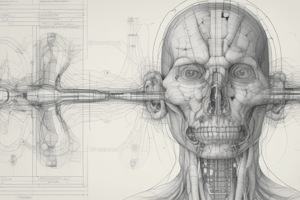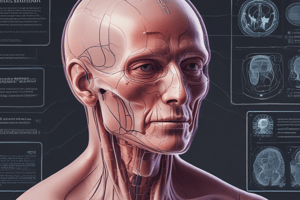Podcast
Questions and Answers
What is the principle behind ultrasound imaging?
What is the principle behind ultrasound imaging?
- Echolocation (correct)
- Radio frequency emission
- Emission of X-rays
- Electromagnetic induction
What is the function of the transducer in ultrasound imaging?
What is the function of the transducer in ultrasound imaging?
- To amplify the ultrasound signals
- To analyze the echo signals
- To display the ultrasound image
- To convert electrical energy into sound waves (correct)
What is the pulse-echo principle based on?
What is the pulse-echo principle based on?
- Reflection of ultrasound waves by tissues
- Transmission of a short pulse of ultrasound energy (correct)
- Refraction of ultrasound waves by tissues
- Continuous transmission of ultrasound energy
What is the speed of ultrasound wave propagation through tissue?
What is the speed of ultrasound wave propagation through tissue?
What determines the wavelength of an ultrasound wave?
What determines the wavelength of an ultrasound wave?
What occurs when an ultrasound wave encounters a boundary between two tissues?
What occurs when an ultrasound wave encounters a boundary between two tissues?
What determines the amount of reflection at a tissue boundary?
What determines the amount of reflection at a tissue boundary?
What corresponds to the brightness of each pixel in the ultrasound image?
What corresponds to the brightness of each pixel in the ultrasound image?
Flashcards are hidden until you start studying
Study Notes
Imaging Formation
Principles of Ultrasound Imaging
- Ultrasound imaging is based on the principle of echolocation, where high-frequency sound waves are transmitted into the body and the echoes that bounce back are used to create images.
- The ultrasound machine transmits ultrasonic waves through a transducer, which converts electrical energy into sound waves.
Pulse-Echo Principle
- The pulse-echo principle is the fundamental concept behind ultrasound imaging.
- A short pulse of ultrasound energy is transmitted into the body, and the echoes that return are detected by the transducer.
- The time delay between the transmitted pulse and the received echo is proportional to the distance of the reflector from the transducer.
Sound Wave Propagation
- Ultrasound waves propagate through tissue at a speed of approximately 1540 m/s.
- The frequency of the ultrasound wave determines its wavelength, with higher frequencies resulting in shorter wavelengths.
- The wavelength of the ultrasound wave affects the resolution of the image, with shorter wavelengths providing higher resolution.
Reflection and Refraction
- When an ultrasound wave encounters a boundary between two tissues of different acoustic properties, some of the energy is reflected back to the transducer.
- The amount of reflection depends on the acoustic impedance mismatch between the two tissues.
- Refraction occurs when the ultrasound wave passes from one tissue to another with a different acoustic velocity, causing the wave to bend.
Image Formation
- The echoes received by the transducer are processed to form a 2D image.
- The image is constructed by scanning the transducer in a specific pattern, such as a sector or linear scan.
- The brightness of each pixel in the image corresponds to the strength of the echo received from that location.
Resolution and Axial Resolution
- Lateral resolution refers to the minimum distance between two objects that can be distinguished in the lateral direction.
- Axial resolution refers to the minimum distance between two objects that can be distinguished in the axial direction.
- The resolution of the image is affected by the frequency of the ultrasound wave, the size of the transducer, and the signal processing algorithms used.
Imaging Formation
Principles of Ultrasound Imaging
- Ultrasound imaging is based on the principle of echolocation, where high-frequency sound waves are transmitted into the body and the echoes that bounce back are used to create images.
- The ultrasound machine converts electrical energy into sound waves through a transducer.
Pulse-Echo Principle
- The pulse-echo principle is the fundamental concept behind ultrasound imaging, involving a short pulse of ultrasound energy transmission and echo detection.
- The time delay between the transmitted pulse and the received echo is proportional to the distance of the reflector from the transducer.
Sound Wave Propagation
- Ultrasound waves propagate through tissue at a speed of approximately 1540 m/s.
- The frequency of the ultrasound wave determines its wavelength, with higher frequencies resulting in shorter wavelengths.
- Shorter wavelengths provide higher resolution images.
Reflection and Refraction
- When an ultrasound wave encounters a boundary between two tissues of different acoustic properties, some of the energy is reflected back to the transducer.
- The amount of reflection depends on the acoustic impedance mismatch between the two tissues.
- Refraction occurs when the ultrasound wave passes from one tissue to another with a different acoustic velocity, causing the wave to bend.
Image Formation
- The echoes received by the transducer are processed to form a 2D image.
- The image is constructed by scanning the transducer in a specific pattern, such as a sector or linear scan.
- The brightness of each pixel in the image corresponds to the strength of the echo received from that location.
Resolution and Axial Resolution
- Lateral resolution refers to the minimum distance between two objects that can be distinguished in the lateral direction.
- Axial resolution refers to the minimum distance between two objects that can be distinguished in the axial direction.
- The resolution of the image is affected by the frequency of the ultrasound wave, the size of the transducer, and the signal processing algorithms used.
Studying That Suits You
Use AI to generate personalized quizzes and flashcards to suit your learning preferences.




